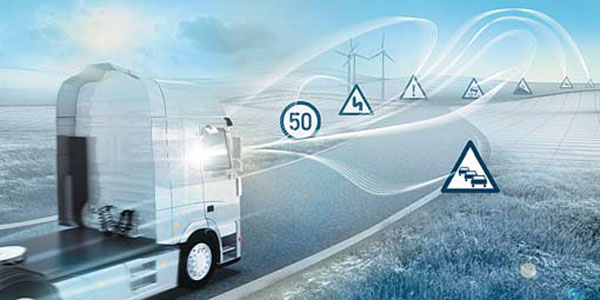Bosch safety functions lead the way to automated driving
Connectivity and autonomous driving are two major development trends to further enhance cars and driving safety, according to German technology provider Bosch.
"One of the Bosch's future R&D focuses will concentrate on the injury-free, accident-free, convenient and automated technologies, which ensure a safe, comfortable and enjoyable driving experience," said Joao Carreiro, marketing director of Bosch's Chassis Systems Control division.
He explained that the technologies could be differentiated in four ways: passive safety, active safety, driver assistance and networking and mobility services.
|
An illustration of a Bosch electronic horizon system. Provided to China Daily |
"These safety related technologies have made Chassis Systems Control one of the largest businesses for Bosch, which generated 30 billion euros revenue in 2013," said Carreiro.
Although China has been the world's largest automobile market for five years, Europe is still the bigger user for safety technology, as 47 percent of the division's revenue came from the continent, while 28 percent came from Asia and 25 percent from North and South America.
"Applying these technologies will greatly help China reduce vehicle accident injuries," he said.
Statistics showed that road accident deaths continued to grow in the recent years and the countries with the largest death tolls were India, China and Brazil.
The statistics suggested that about 90 percent of road deaths were caused by driver mistakes.
The United Nations appealed to reduce road deaths by 50 percent, or from 1.9 million to 0.9 million annually, between 2010 and 2020, and Carreiro said Bosch products could help do this.
In 1978 the company invented the Anti-Lock Braking system, or ABS. It was the first automated system that allowed wheels to maintain tractive contact with the road surface according to driver inputs while braking. The system prevents wheels from locking up and avoids uncontrolled skidding.
In 1995 the Electronic Stability Program. or ESP, which avoids 80 percent of uncontrolled sideslips, hit the market.
"Nobody operating the car is the ultimate and ideal target of autonomous driving. All the connectivity and assistance technologies for safety concerns are necessary and step-by-step to achieve that goal," said Carreiro. "And Bosch is leading the pack."
Bosch believes the route from driver assistance to complete autonomous driving can be split into three phases.
The first stage, which requires the driver to continue to control the vehicle and is partly supported by automated technologies, is well underway.
For example, the semi-automated parking supportive system - park steering and park maneuver control, which several existing cars are equipped with, still need the driver to control the accelerator pedal.
In the pipeline
From next year, a complete parking assistant system, which the driver can control from outside the car, will be put into mass production by Bosch.
"Around 2020, connected vehicles will easily park by themselves, even without the drivers' supervision, through the auto park pilot and the valet parking in car technologies," predicted Carreiro.
A similar step-by-step path towards complete autonomous highway driving is also planned. An integrated cruise assist function to provide both longitudinal and lateral guidance is expected to soon be in production, said Carreiro.
Bosch tested a demonstration car equipped with highway assist on a public highway. At a top speed of 130km/h, the technician removed his hands from the steering wheel. "The highway pilot should be feasible for around 2020. The real autopilot, which also considers urban situations, however, should be expected much later," said Carreiro.
Interest in the new technologies is increasing, especially in China, according to Carreiro. "Now all the new models applying for the Five-Star rating in crash test in Europe should be equipped with at least one driver assistance system, while China's testing institution is considering including the Automatic Emergency Braking, or AEB, test from 2018."
All these technologies can be created through computerized components such as sensors, cameras and electronic control units, all of which can enable connectivity. Bosch believes its driving assistance functions are among those that are leading the way to automated driving.
As the Consumer Electronics Show in Las Vegas illustrated this year, the number of connected devices is rapidly growing and the trend towards networking is unabated.
"All electronic devices in our environment can be connected to one another via the Internet. This means that billions of single parts are set to morph into an enormous new whole. This will happen for certain. As entrepreneurs, we must see to it that we recognize and seize the ensuing opportunities," said Volkmar Denner, chairman of the Bosch board of management. The company estimated that more than 75 percent of the global population and 6.6 billion devices will be connected to the Internet by 2015, which will bring more convenience to daily life and significantly improve energy efficiency.
"The Internet of things and services is now a hot topic in China, and we expect stronger momentum in the Internet of vehicles in the coming years," said Chen Yudong, president of Bosch China. "As an innovative company, Bosch is ready for the business opportunities it brings us."
Leveraging its sensor and software technologies, Bosch is working to establish the frameworks and foundations of connectivity in China. Bosch Sensortec, a subsidiary that specializes in MEMS (Micro-Electro-Mechanical Systems) technology, launched its Asia-Pacific headquarters in Shanghai in 2013.
The company develops and markets micro-mechanical sensors for consumer electronics, mobile phones, safety systems, industrial technology and logistics. Every other smartphone across the globe now uses Bosch sensors.
While MEMS technologies are regarded as the hardware basis for connectivity, Bosch Software Innovations launched a pilot project for promoting electric vehicle's charging application in Shanghai in 2013.
lifangfang@chinadaily.com.cn



















